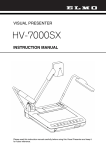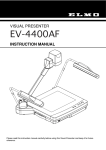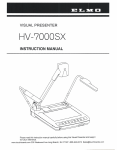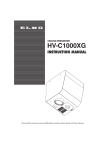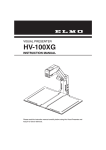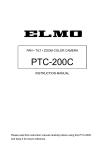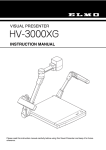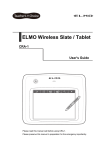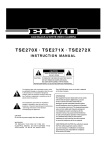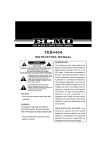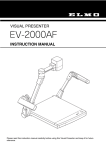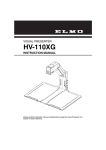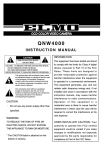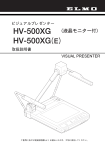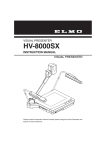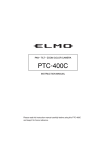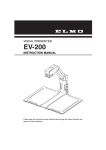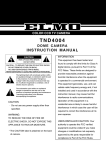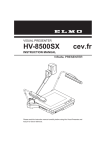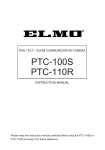Download Elmo HV-5000XG Instruction manual
Transcript
VISUAL PRESENTER INSTRUCTION MANUAL Please read this instruction manual carefully before using this Visual Presenter and keep it for future reference. IMPORTANT SAFEGUARDS Read Instructions - All the safety and operating instructions should be read before the appliance is operated. Power Sources - This product should be operated only from the type of power source indicated on the marking label. If you are not sure of the type of power supply to your home consult your appliance dealer or local power company. For products intended to operate from battery power, or other sources, refer to the operating instructions. Retain Instructions - The safety and operating instructions should be retained for future reference. Heed Warnings - All warnings on the product and in the operating instructions should be adhered to. Grounding or Polarization - This product may be equipped with either a polarized 2-wire AC line plug (a plug having one blade wider than the other) or a 3-wire grounding type plug, a plug having a third (grounding) pin. The 2-wire polarized plug will fit into the power outlet only one way. This is a safety feature. If you are unable to insert the plug fully into the outlet, try reversing the plug. If the plug still fails to fit, contact your electrician to replace your obsolete outlet. Do not defeat the safety purpose of the polarized plug. The 3-wire grounding type plug will fit into a grounding type power outlet. This is a safety feature. If you are unable to insert the plug into the outlet, contact your electrician to replace your obsolete outlet. Do not defeat the safety purpose of the grounding type plug. Follow Instructions - All operating and use instructions should be followed. Cleaning - Unplug this product from the wall outlet before cleaning. Do not use liquid cleaners or aerosol cleaners. Use a damp cloth for cleaning. Attachments - Do not use attachments not recommended by the product manufacturer as they may cause hazards. Water and Moisture - Do not use this product near water - for example, near a bath tub, wash bowl, kitchen sink, or laundry tub, in a wet basement, or near a swimming pool, and the like. Power-Cord Protection - Power-supply cords should be routed so that they are not likely to be walked on or pinched by items placed upon or against them, paying particular attention to cords at plugs, convenience receptacles, and the point where they exit from the product. Accessories - Do not place this product on an unstable cart, stand, tripod, bracket, or table. The product may fall, causing serious injury to a child or adult, and serious damage to the product. Use only with a cart, stand, tripod, bracket, or table recommended by the manufacturer, or sold with the product. Any mounting of the product should follow the manufacturer's instructions, and should use a mounting accessory recommended by the manufacturer. Lightning - For added protection for this product during a lightning storm, or when it is left unattended and unused for long periods of time, unplug it from the wall outlet and disconnect the antenna or cable system. This will prevent damage to the product due to lightning and power-line surges. Ventilation - Slots and openings in the cabinet are provided for ventilation and to ensure reliable operation of the product and to protect it from overheating, and these openings must not be blocked or covered. The openings should never be blocked by placing the product on a bed, sofa, rug, or other similar surface. This product should not be placed in a built-in installation such as a bookcase or rack unless proper ventilation is provided or the manufacturer's instructions have been adhered to. Overloading - Do not overload wall outlets, extension cords, or integral convenience receptacles as this can result in a risk of fire or electric shock. A product and cart combination should be moved with care. Quick stops, excessive force, and uneven surfaces may cause the product and cart combination to overturn. 1 Object and Liquid Entry - Never push objects of any kind into this product through openings as they may touch dangerous voltage points or short-out parts that could result in a fire or electric shock. Never spill liquid of any kind on the product. CAUTION RISK OF ELECTRIC SHOCK DO NOT OPEN CAUTION: Servicing - Do not attempt to service this product yourself as opening or removing covers may expose you to dangerous voltage or other hazards. Refer all servicing to qualified service personnel. Damage Requiring Service - Unplug this product from the wall outlet and refer servicing to qualified service personnel under the following conditions: • When the power-supply cord or plug is damaged. SA 1965 TO REDUCE THE RISK OF ELECTRIC SHOCK, DO NOT REMOVE COVER (OR BACK). NO USER-SERVICEABLE PARTS INSIDE. REFER SERVICING TO QUALIFIED SERVICE PERSONNEL. The lightning flash with arrowhead symbol, within an equilateral triangle, is intended to alert the user to the presence of uninsulated "dangerous voltage" within the product's enclosure that may be of sufficient magnitude to constitute a risk of electric shock to persons. This marking is located at the bottom of product. The exclamation point within an equilateral triangle is intended to alert the user to the presence of important operating and maintenance (servicing) instructions in the literature accompanying the product. • If liquid has been spilled, or objects have fallen into the product. • If the product has been exposed to rain or water. • If the product does not operate normally by following the operating instructions. Adjust only those controls that are covered by the operating instructions as an improper adjustment of other controls may result in damage and will often require extensive work by a qualified technician to restore the product to its normal operation. SA 1966 WARNING: TO REDUCE THE RISK OF FIRE OR ELECTRIC SHOCK, DO NOT EXPOSE THIS PRODUCT TO RAIN OR MOISTURE. • If the product has been dropped or damaged in any way. • When the product exhibits a distinct change in performance - this indicates a need for service. INFORMATION This equipment has been tested and found to comply with the limits for a Class A digital device, pursuant to Part 15 of the FCC Rules. These limits are designed to provide reasonable protection against harmful interference when the equipment is operated in a commercial environment. This equipment generates, uses, and can radiate radio frequency energy and, if not installed and used in accordance with the instruction manual, may cause harmful interference to radio communications. Operation of this equipment in a residential area is likely to cause harmful interference in which case the user will be required to correct the interference at his own expense. Replacement Parts - When replacement parts are required, be sure the service technician has used replacement parts specified by the manufacturer or have the same characteristics as the original part. Unauthorized substitutions may result in fire, electric shock or other hazards. Safety Check - Upon completion of any service or repairs to this product, ask the service technician to perform safety checks to determine that the product is in proper operating condition. Heat - The product should be situated away from heat sources such as radiators, heat registers, stoves, or other products (including amplifiers) that produce heat. USER-INSTALLER CAUTION: Your authority to operate this FCC verified equipment could be voided if you make changes or modifications not expressly approved by the party responsible for compliance to Part 15 of the FCC rules. 2 BEFORE YOU USE Use the Visual Presenter under the rated electrical conditions. Do not leave the Presenter under direct sunlight or by heaters, or the Presenter may be discolored, deformed, or damaged. Do not place the Presenter in any humid, dusty, windy or vibrating location. Use the Presenter in the following environmental conditions: Temperature: 5 C~40 C (41 F~104 F) Humidity: 30~85% (No condensation) Use a soft, dry cloth for cleaning. Do not use any volatile solvent, such as thinner or benzine. Do not directly point the camera lens into the sun, or the camera may be damaged. Caring for the batteries : - If the Presenter is not used for a long time, take out the batteries from the case. - Do not use rechargeable Ni-Cd batteries. - Do not use new and old batteries, or batteries of different types together. - Do not try to recharge or short-circuit the batteries. 3 CONTENTS 1. PART NAMES AND FUNCTIONS . . . . . . . . . . . . . . . . . . . . . . . . . . . . . . . . . . . . . . . . . . . . . .6 Appearance . . . . . . . . . . . . . . . . . . . . . . . . . . . . . . . . . . . . . . . . . . . . . . . . . . . . . . . . . . . . . . . . . . . . . . . . . . . . . . . . .6 Front Operation Panel . . . . . . . . . . . . . . . . . . . . . . . . . . . . . . . . . . . . . . . . . . . . . . . . . . . . . . . . . . . . . . . . .7 Rear Panel . . . . . . . . . . . . . . . . . . . . . . . . . . . . . . . . . . . . . . . . . . . . . . . . . . . . . . . . . . . . . . . . . . . . . . . . . .8 Head . . . . . . . . . . . . . . . . . . . . . . . . . . . . . . . . . . . . . . . . . . . . . . . . . . . . . . . . . . . . . . . . . . . . . . . . . . . . . .9 Wireless Remote Control . . . . . . . . . . . . . . . . . . . . . . . . . . . . . . . . . . . . . . . . . . . . . . . . . . . . . . . . . . . . . . .10 2. WIRELESS REMOTE CONTROL11 Preparation . . . . . . . . . . . . . . . . . . . . . . . . . . . . . . . . . . . . . . . . . . . . . . . . . . . . . . . . . . . . . . . . . . . . . . . . .11 3. SETTING UP . . . . . . . . . . . . . . . . . . . . . . . . . . . . . . . . . . . . . . . . . . . . . . . . . . . . . . . . . .12 Connection to the monitor and the projector . . . . . . . . . . . . . . . . . . . . . . . . . . . . . . . . . . . . . . . . . . . . . . . .13 Connection to the RGB-in terminal Connection to the composite video-in terminal Connection to the S-video-in terminal RGB input signal . . . . . . . . . . . . . . . . . . . . . . . . . . . . . . . . . . . . . . . . . . . . . . . . . . . . . . . . . . . . . . . . . . . . .14 Signal assignment Pin arrangement RGB output signal . . . . . . . . . . . . . . . . . . . . . . . . . . . . . . . . . . . . . . . . . . . . . . . . . . . . . . . . . . . . . . . . . . . .14 Signal assignment (DSUB 15P shrinking terminal) Connection to DC OUT Terminal . . . . . . . . . . . . . . . . . . . . . . . . . . . . . . . . . . . . . . . . . . . . . . . . . . . . . . . . .15 4. OPERATION PROCEDURES . . . . . . . . . . . . . . . . . . . . . . . . . . . . . . . . . . . . . . . . . . . . .16 Simple steps for presenting printed material . . . . . . . . . . . . . . . . . . . . . . . . . . . . . . . . . . . . . . . . . . . . . . . .16 Simple steps for showing transparent material, such as overhead transparency . . . . . . . . . . . . . . . . . . . .17 Using the main camera as a conventional video camera . . . . . . . . . . . . . . . . . . . . . . . . . . . . . . . . . . . . . .17 Storing the Presenter . . . . . . . . . . . . . . . . . . . . . . . . . . . . . . . . . . . . . . . . . . . . . . . . . . . . . . . . . . . . . . . . . .18 5. VARIOUS FUNCTIONS . . . . . . . . . . . . . . . . . . . . . . . . . . . . . . . . . . . . . . . . . . . . . . . . . .19 Lighting . . . . . . . . . . . . . . . . . . . . . . . . . . . . . . . . . . . . . . . . . . . . . . . . . . . . . . . . . . . . . . . . . . . . . . . . . . . .19 Input selection . . . . . . . . . . . . . . . . . . . . . . . . . . . . . . . . . . . . . . . . . . . . . . . . . . . . . . . . . . . . . . . . . . . . . . .19 Monitor output . . . . . . . . . . . . . . . . . . . . . . . . . . . . . . . . . . . . . . . . . . . . . . . . . . . . . . . . . . . . . . . . . . . . . . .20 Table of video-in/out terminal selections Table of signal correspondence NTSC/PAL switching . . . . . . . . . . . . . . . . . . . . . . . . . . . . . . . . . . . . . . . . . . . . . . . . . . . . . . . . . . . . . . . . . .21 Position adjustment . . . . . . . . . . . . . . . . . . . . . . . . . . . . . . . . . . . . . . . . . . . . . . . . . . . . . . . . . . . . . . . . . . .22 Image size adjustment . . . . . . . . . . . . . . . . . . . . . . . . . . . . . . . . . . . . . . . . . . . . . . . . . . . . . . . . . . . . . . . . .22 Zoom . . . . . . . . . . . . . . . . . . . . . . . . . . . . . . . . . . . . . . . . . . . . . . . . . . . . . . . . . . . . . . . . . . . . . . . . . . . . . .22 Focus . . . . . . . . . . . . . . . . . . . . . . . . . . . . . . . . . . . . . . . . . . . . . . . . . . . . . . . . . . . . . . . . . . . . . . . . . . . . . .23 Auto Focus Powered Manual Focus Iris . . . . . . . . . . . . . . . . . . . . . . . . . . . . . . . . . . . . . . . . . . . . . . . . . . . . . . . . . . . . . . . . . . . . . . . . . . . . . . . .24 LCD monitor bracket socket . . . . . . . . . . . . . . . . . . . . . . . . . . . . . . . . . . . . . . . . . . . . . . . . . . . . . . . . . . . .24 4 6. RS-232C SPECIFICATIONS . . . . . . . . . . . . . . . . . . . . . . . . . . . . . . . . . . . . . . . . . . . . . .25 Setting up . . . . . . . . . . . . . . . . . . . . . . . . . . . . . . . . . . . . . . . . . . . . . . . . . . . . . . . . . . . . . . . . . . . . . . . . . . .25 Cable connection . . . . . . . . . . . . . . . . . . . . . . . . . . . . . . . . . . . . . . . . . . . . . . . . . . . . . . . . . . . . . . . . . . . . .25 RS-232C connector specifications (DSUB 9P) . . . . . . . . . . . . . . . . . . . . . . . . . . . . . . . . . . . . . . . . . . . . . .25 Table of the communication commands . . . . . . . . . . . . . . . . . . . . . . . . . . . . . . . . . . . . . . . . . . . . . . . . . . .26 Data format specifications . . . . . . . . . . . . . . . . . . . . . . . . . . . . . . . . . . . . . . . . . . . . . . . . . . . . . . . . . . . . . .27 Transmission command (PC Visual Presenter) Response data format (Visual Presenter PC) Transmission specifications . . . . . . . . . . . . . . . . . . . . . . . . . . . . . . . . . . . . . . . . . . . . . . . . . . . . . . . . . . . . .27 Connection . . . . . . . . . . . . . . . . . . . . . . . . . . . . . . . . . . . . . . . . . . . . . . . . . . . . . . . . . . . . . . . . . . . . . . . . . .27 7. TROUBLESHOOTING HINTS . . . . . . . . . . . . . . . . . . . . . . . . . . . . . . . . . . . . . . . . . . . . .28 8. SPECIFICATIONS . . . . . . . . . . . . . . . . . . . . . . . . . . . . . . . . . . . . . . . . . . . . . . . . . . . . . .29 General Camera Lighting Supplied accessories Options 5 1. PART NAMES AND FUNCTIONS Appearance 3. Camera Head 7. Lighting Unit Arm 8. Lighting Unit 7. Lighting Unit Arm 2. Column 4. Close-up Lens Holder 8. Lighting Unit Attach this holder for normal use. Swing away this holder for viewing a far-away object. 14. Monitor Bracket Socket 6. Power Switch 10. Carrying Handle 11. Wireless Remote Control 5. Column Lock Release Button Press this button to raise/fold the Column. 1. Stage 9. Front Operation Panel 13. Infrared Sensor 6 12. Remote Control Storage Compartment Front Operation Panel 15. Lighting Buttons 16. Input Selection Buttons 20. Monitor output Buttons 18. Focus Buttons Part Name 17. Zoom Buttons 19. Auto Focus Button Function Reference Page 15 Lighting Buttons To turn ON/OFF the lighting unit. P.19 16 Input Selection Buttons To change the input line. P.19 17 Zoom Buttons To change the image size. P.22 18 Focus Buttons To adjust focus (powered). P.23, P.24 19 Auto Focus Button To focus automatically. P.23 This is of one-shot auto focus system (FOCUSFREE). 20 Monitor output Buttons To select the signal to be output to the NTSC/PAL monitor. To change the Monitor output mode (NTSC/PAL) using the built-in camera button. 7 P.20, P.22 P.21 Rear Panel 21. Power Cord Receptacle 22. AC Outlet 24. Infrared Sensor 26. Analog RGB Output Terminal 28. Video-in Terminal 1 OUTLET UNSWITCHED RGB1 RGB OUT AC120V~60Hz (MAX. 3.2A) RGB2 S-VIDEO VIDEO 12V 0.9A 23. DC Output Terminal 25. RS-232C Terminal Part Name 29. Video-in Terminal 2 27. Video-out Terminal - S-Video (mini DIN 4P)/ - Composite-Video (RCA pinjack) Function 21 Power Cord Receptacle [AC IN] Connected to the power cord. 22 AC Outlet To supply power up to 400W (Not interlocked with the power switch). 23 DC Output Terminal To output 12VDC. The LCD Color Monitor (LM-5011N) or [OUTPUT] ELMO Desk-top Presenter (HD-80XG) can be connected with the Reference Page supplied DC cable. Note: Do not connect any equipment other than LM-5011N and HD-80XG. 24 Infrared Sensor The light receiver of the wireless remote control. When operating P.11 the Presenter from behind, aim the wireless remote control at this light receiver. 25 26 27 RS-232C Terminal To connect a PC with an RS-232C cable to control the Presenter from [RS-232C] the PC. Analog RGB Output Terminal To connect RGB input equipment, such as an LCD Projector and a [OUTPUT ⋅ RGB OUT] Multi-SYNC Monitor, to output the image. Video-out Terminal To connect a NTSC/PAL conformable monitor, such as a TV P.25 [OUTPUT ⋅ S-VIDEO/VIDEO] monitor and the LCD Color Monitor (LM-5011N), to output the S-Video (mini DIN 4P) image. Composite-Video (RCA pinjack) 28 29 Video-in Terminal 1 Video signal from this terminal is output when input selection is set [INPUT ⋅ RGB1] at RGB1. Video-in Terminal 2 Video signal from this terminal is output when input selection is set [INPUT ⋅ RGB2] at RGB2. 8 P.19 P.19 Head 31. Shutter selection switch 30. Gamma selection switch OFF 60 ON 50 Part Name 31 Gamma selection switch Function Gamma selection is used for adjusting the luminance shade with the device to connect RGB output to. Generally, it is recommended to use ON when connecting to the CRT monitor; use OFF when connecting to the LCD projector. The luminance shade may not match depending on the type of projector. Use ON in such a case. 32 Shutter selection switch In an area where power frequency is 50Hz, using the unit with flicker correction switch set to [60] may cause flickering due to illumination of AC power discharge tube, such as a fluorescent or a mercury lamp. Using the unit the flicker correction switch set to [50] may reduce the flickering. This switch is factory-set to 60Hz. 9 Reference Page Wireless Remote Control 32. Position 33. UPPER 34. BASE 35. MAIN 37. RGB2 36. RGB1 38. TELE 41. FAR 39. WIDE 40. NEAR 42. AF 43. IRIS NORMAL 45. IRIS CLOSE 44. IRIS OPEN Button Name Function Reference Page 32 POSITION To adjust the screen position and image size of the video output. P.22 33 UPPER To turn ON/OFF the upper lighting unit. P.19 34 BASE To turn ON/OFF the base lighting unit. P.19 35 MAIN To select the image from the built-in camera. P.19 36 RGB1 To select the RGB1 image input. P.19 37 RGB2 To select the RGB2 image input. P.19 38 TELE To zoom in. P.22 39 WIDE To zoom out. P.22 40 NEAR To move the focus near. P.23, P.24 41 FAR To move the focus far. P.23, P.24 42 AF To focus automatically. P.23 43 IRIS NORMAL To iris automatically. P.24 44 IRIS OPEN To open the iris manually. P.24 45 IRIS CLOSE To close the iris manually. P.24 10 2. WIRELESS REMOTE CONTROL Point the infrared emitting part of the wireless remote control unit at the infrared sensor of the Presenter, located at the front, and the rear panel, and press the button for the desired function. The infrared sensor at the front can receive the infrared light if it comes from the wireless remote control within 7 meters at an angle of 30 degrees or less right and left. (5 degrees or less right and left for rear panel sensor.) The sensitivity may be degraded when the Presenter is located under sunlight, or near inverter fluorescent lamps, or in any other unfavorable surroundings. Depending on the conditions of fluorescent lamps, etc. the sensor may fail to receive the infrared light. In such a case, relocate the Presenter, or take other countermeasures. Preparation Remove the battery case cover by pressing downward on the [ ] mark part in the direction as indicated by the arrow. Install 2 pcs. of batteries (type R03, AAA) into the case in the direction as indicated there. Notes:- Install the batteries with the right polarity. - Change the batteries once a year. - The batteries supplied with the Presenter are only for use in initially confirming the operation of the Presenter. It is not guaranteed that these batteries can work effectively for the indicated period. 11 3. SETTING UP (1) Unfold the lighting unit arms fully until they come to the dead end. Unfold arm 1 and then arm 2 as illustrated. (2) Press the column lock release button, and raise the column until the column lock release button returns to the original position. Make sure that the column has been completely locked. (3) Rotate the camera head to direct the lens unit to the stage. (4) Plug the power cord into the power cord receptacle of the Presenter and the AC outlet. 12 Connection to the monitor and the projector Notes: - Be sure to turn OFF the power supply to all equipment before making any connections to protect the Presenter and all the connected equipment. - Hold the cable plug part when connecting or disconnecting the cables. Connection to the RGB-in terminal Connect the RGB output terminal of the Presenter to the RGB input terminal of the equipment with the supplied VGA cable or a RGB connection cable available on the market. If the display image shifts from the center, manually adjust the horizontal/vertical positions through the connected equipment. If vertical stripes appear on the screen with the use of video projector, it may be improved by manually adjusting the dot-clock frequency of the projector. Projector AC IN INPUT RGB1 OUTPUT RGB OUT RS-232C OUTLET UNSWITCHED AC120V~60Hz (MAX. 3.2A) Monitor OUTPUT RGB2 S-VIDEO VIDEO 12V 0.9A Connection to the composite video-in terminal Use the supplied RCA video cable with RCA pin plug. Note: The video output of this Presenter is set to NTSC before shipment from our factory. To connect to the PAL monitor, switch the down converter output mode from NTSC to PAL. Reference Page - NTSC/PAL switching P.21 TV monitor AC IN RS-232C OUTLET UNSWITCHED OUTPUT RGB OUT INPUT RGB1 AC120V~60Hz (MAX. 3.2A) OUTPUT RGB2 S-VIDEO VIDEO 12V 0.9A LCD monitor Connection to the S-video-in terminal Connect the S-video-out terminal (mini DIN 4P) of the Presenter to the S-video-in terminal of the monitor. For the S-video output mode, use the supplied 4P mini DIN cable (for S-video) or an S-vide connection cable available on the market. If the equipment to be used is provided with a Y/C separate connector, a conversion adapter is necessary. AC IN RS-232C OUTLET UNSWITCHED OUTPUT RGB OUT INPUT RGB1 AC120V~60Hz (MAX. 3.2A) OUTPUT RGB2 S-VIDEO VIDEO 12V 0.9A 13 TV monitor RGB input signal Signal assignment 5 4 3 10 9 2 8 Input signal 1 7 6 15 14 13 12 11 DSUB 15P shrinking terminal (Female) Video signal Analog Horizontal synchronizing signal TTL level (positive/negative polarity) Vertical synchronizing signal TTL level (positive/negative polarity) Composite synchronizing signal TTL level (positive/negative polarity) 0.7V(p-p) 75Ω Pin arrangement Pin No. Name Pin No. Name Pin No. Name 1 Video input (Red) 6 GND (Red) 11 GND 2 Video input (Green) 7 GND (Green) 12 NC 3 Video input (Blue) 8 GND (Blue) 13 4 NC 9 NC 5 GND 10 GND Horizontal synchronizing/ composite synchronizing signal 14 Vertical synchronizing signal 15 NC RGB output signal Signal assignment (DSUB 15P shrinking terminal) Pin No. Name Pin No. Name Pin No. Name 1 Video output (Red) 6 GND (Red) 11 GND 2 Video output (Green) 7 GND (Green) 12 NC 3 Video output (Blue) 8 GND (Blue) 13 Horizontal synchronizing signal 4 NC 9 NC 14 Vertical synchronizing signal 5 GND 10 GND 15 NC 14 Connection to DC OUT Terminal Use the DC OUT terminal to connect ELMO Desk-top Presenter (HD-80XG) and the LCD Monitor (LM-5011N). Analog RGB cable for HD-80XG use only (supplied with HD-80XG) To INPUT RGB1 or INPUT RGB2 AC IN RS-232C OUTLET UNSWITCHED INPUT RGB1 OUTPUT RGB OUT AC120V~60Hz (MAX. 3.2A) HD-80XG LM-5011N OUTPUT RGB2 S-VIDEO VIDEO 12V 0.9A DC IN 12V DC OUT terminal DC IN 12V DC cable (supplied) Notes: - When using the DC cable (supplied), AC adapter supplied with HD-80XG/LM-5011N is not used. - Do not connect any equipment other than HD-80XG and LM-5011N to the DC OUT terminal. 15 4. OPERATION PROCEDURES Simple steps for presenting printed material (1) Turn ON the power switch. Note: - Before turning ON the power switch, connection to the monitor should have been completed. - The indication lamp (green LED) on the front operation panel shows the initial setting condition of each function of the Presenter. - If the power switch is turned ON immediately after being turned OFF, the Presenter may not operate. For restarting, turn ON the power switch several seconds after turning OFF. (2) Place the object on the stage. Adjust the image size according to the object size using the zoom buttons [TELE] and [WIDE] on the operation panel or wireless remote control, while watching the image on the monitor. Front operation panel Wireless remote control (3) Press the auto focus button [AF] on the front operation panel or remote control for focusing. Front operation panel Note: The auto focus function works up to a height of approx. 10 cm above the stage surface. Wireless remote control 16 Simple steps for showing transparent material, such as overhead transparency (1) Press the base button [BASE] on the front operation panel or wireless remote control. The indicator of the base button [BASE] will blink, and the built-in baselight will light up. Front operation panel Wireless remote control (3) To turn OFF the baselight, press the base button [BASE] on the front operation panel or wireless remote control. Front operation panel Wireless remote control Using the main camera as a conventional video camera Set the main camera head horizontally to shoot the objects, such as walls and distant views. To shoot distant objects, swing up the close-up lens holder. Reference The focus can be achieved from 1.1m to . Close-up lens holder 17 Storing the Presenter Note: The Presenter can not be stored with the LCD monitor (optional) attached. Before storing, detach the LCD monitor (optional) and monitor bracket (optional), if connected. (1) Turn OFF the power switch, and unplug the power cord and the video cable. (2) Press the column lock release button, and fold down the main column. Note: The illustration shows the storage position of the column. Never apply excessive force to the column. (3) Fold down the lighting unit arms 3 and 4. Be sure to fold down arm 3 first as per the illustration. 18 5. VARIOUS FUNCTIONS Lighting The upper lighting unit for presenting material such as printed matter and 3-D object, and the baselight for presenting transparent material, such as slide are built in the Presenter. Depending on the material to be presented, press the button [UPPER] or [BASE] on the front operation panel or wireless remote control. The indication lamp will blink for a few seconds, and then the fluorescent lamp will light up. To turn OFF the lamp, press the button for the respective lamp. It has been so set before shipment that the lighting unit lights up when the power supply is turned ON. Front operation panel Wireless remote control Notes: - It is impossible to have the upper lighting unit and the baselight lit up together. - When the lightness of the material surface is not sufficiently high or a 3-D object is presented, a sharp image with good color rendering can be obtained with the upper lighting unit. - To reduce glare, attach enclosed stickers, as shown, to the outside ends, of toplights. Input selection The respective images from two different AV sources, such as PC and ELMO Presenter [HD-80XG], connected to Video-in Terminal 1 [INPUT] [RGB1] and Video-in Terminal 2 [INPUT] [RGB2] respectively, can be alternately presented on the Monitor by simply selecting the AV source by pressing the input selection button without changing cable connections. Press the input selection button [RGB1] / [RGB2] on the front operation panel or wireless remote control. When the built-in camera button [MAIN] on the front operation panel or wireless remote control is pressed, the image by the built-in camera is resumed. 19 Front operation panel Wireless remote control Monitor output The signal to be outputted to the NTSC/PAL monitor is selected. When the input has been set to RGB1 or RGB2 and the monitor output button [RGB1/RGB2] on the front operation panel is pressed, the indicator lamp is switched accordingly, and the images by the equipment connected to the external input terminals [RGB1] and [RGB2] are presented on the NTSC/PAL monitor. The signals to be outputted are as shown in Table below on the next page. When the built-in camera button [MAIN] in the monitor output on the front operation panel is pressed, the indicator lamp is switched accordingly, and the image by the built-in camera is displayed on the NTSC/PAL monitor. Front operation panel Notes: - When the built-in camera button [MAIN] in the input selection on the front operation panel or wireless remote control is pressed, the image by the built-in camera is resumed. - Of all signals inputted into the external input terminals [RGB1] and [RGB2], those signals having the frequencies as specified in the following page can be outputted to the NTSC/PAL monitor. Table of video-in/out terminal selections Output signal Input Input selection MAIN RGB output terminal Composite output terminal S-video terminal Monitor output : When MAIN is selected Main camera input image Main camera input image Monitor output : When RGB1/RGB2 is selected Main camera input image Main camera input image * Main camera input image * Main camera input image Monitor output : When MAIN is selected RGB1 input image Main camera input image Main camera input image Monitor output : When RGB1/RGB2 is selected RGB1 input image RGB1 input image RGB1 input image Input selection Monitor output : When MAIN is selected RGB2 input image Main camera input image Main camera video RGB2 RGB2 input image RGB2 input image RGB2 input image Input selection RGB1 Monitor output : When RGB1/RGB2 is selected Note: *When the input selection is the built-in camera (MAIN), RGB1/RGB2 cannot be selected for the monitor output. 20 Table of signal correspondence Signal Mode VGA1 VGA2 VGA3 VGA@60Hz VGA@72Hz VGA@75Hz VGA@85Hz SVGA@56Hz SVGA@60Hz SVGA@72Hz SVGA@75Hz SVGA@85Hz XGA@60Hz XGA@70Hz XGA@75Hz XGA@85Hz SXGA1 SXGA2 SXGA3 SXGA@60Hz SXGA@75Hz SXGA@85Hz UXGA@60Hz UXGA@65Hz UXGA@70Hz UXGA@75Hz UXGA@85Hz Mac 13 Mac 16 Mac 19 Mac 21 PC98 Frequency Fh Fv Pixels clock kHz Hz MHz 37.861 37.861 37.927 31.469 37.861 37.500 43.269 35.156 37.879 48.077 46.875 53.674 48.363 56.476 60.023 68.677 67.500 60.000 85.938 63.981 79.976 91.146 75.000 81.250 87.500 93.750 106.250 35.000 49.725 60.241 68.682 24.825 85.080 85.080 85.039 59.940 72.809 75.000 85.008 56.250 60.317 72.188 75.000 85.061 60.004 70.069 75.029 84.997 75.000 60.000 85.002 60.020 75.025 85.024 60.000 65.000 70.000 75.000 85.000 66.667 74.550 74.927 75.062 56.420 31.500 31.500 35.500 25.175 31.500 31.500 36.000 36.000 40.000 50.000 49.500 56.250 65.000 75.000 78.750 94.500 108.000 108.000 148.500 108.000 135.000 157.500 162.000 175.500 189.000 202.500 229.500 30.240 57.283 80.000 100.000 21.052 Resolution (number of lines) Fh 640 640 720 640 640 640 640 800 800 800 800 800 1024 1024 1024 1024 1152 1280 1280 1280 1280 1280 1600 1600 1600 1600 1600 640 832 1024 1152 640 Polarity of synchronizing signal Fv 350 400 400 480 480 480 480 600 600 600 600 600 768 768 768 768 864 960 960 1024 1024 1024 1200 1200 1200 1200 1200 480 624 768 870 400 NTSC/PAL switching To switch the monitor output mode (NTSC/PAL.) It is set to NTSC before shipment from our factory. To switch the NTSC mode to PAL, turn the power switch ON, while pressing the monitor output button [MAIN] on the operation panel. To return to NTSC, repeat the same operation. Note: When the power supply is turned on the next time, the lastly selected TV mode is maintained. NTSC is the TV standards in North America. 21 Front operation panel Positive ( P: N: Negative ) H/V P/N N/P N/P N/N N/N N/N N/N P/P P/P P/P P/P P/P P/P N/N N/N P/P P/P P/P P/P P/P P/P P/P P/P P/P P/P P/P P/P P/P N/N N/N N/N N/N Position adjustment To adjust the display position of the image outputted on the NTSC/PAL monitor. Press the buttons [POSITION] ( ) to adjust Wireless remote control the image to the proper position. Notes: - The adjusted position is memorized in the Presenter. However, if the frequency of the signal to be inputted into the external input terminal [RGB1] or [RGB2], readjust the position. - The image from the built-in camera cannot be adjusted. Image size adjustment Front operation panel To adjust the display size of the image outputted on the NTSC/PAL monitor. Press position buttons [POSITION] ( ) on the wireless remote control while holding down the monitor output buttons [RGB1/RGB2] on the front operation panel to adjust the display size of the image to the proper size. Wireless remote control Notes: - When the image size is adjusted, the image center may be displaced. If the image center is displaced, execute the position adjustment to correct the displacement of the image center. - The adjusted position is memorized in the Presenter. However, if the frequency of the signal to be inputted into the external input terminal [RGB1] or [RGB2], readjust the position. - The image from the built-in camera cannot be adjusted. Zoom Front operation panel Press the zoom button [TELE] on the front operation panel or wireless remote control, and the image will gradually be enlarged. Wireless remote control Press the zoom button [WIDE] on the front operation panel or wireless remote control, and the image will be gradually reduced. Front operation panel Wireless remote control 22 Focus Auto Focus To operate Auto-Focus, press the auto focus button [AF] on the front operation panel or wireless remote control, and the Auto-Focus will be activated. While the auto-focus is in operation, the indication lamp blinks until the object is brought into focus. Front operation panel Wireless remote control The Presenter features a one-push auto focus function. Once focusing is completed, the auto focus function is released, and the focused position maintains unchanged. (FOCUSFREE) To obtain sharper image, zoom in on the object in the autofocus mode while pressing the zoom button [TELE] on the front operation panel or wireless remote control. However, the objects listed below may not be brought into focus in the auto focus mode. In these cases, use the manual focus mode. · Objects bearing little contrast · Objects with fine repeated patterns, such as lateral stripes and cross stripes · Objects glittering or reflecting strong light · Objects with bright background, or excessive contrast · Objects in a dark picture plane · Objects located near and far away at the same time · Objects in motion If the focus button [NEAR] or [FAR] on the front operation panel or wireless remote control is pressed during the auto focus, the auto focus will be released. Front operation panel Wireless remote control Front operation panel Notes: - The auto focus functions up to approx. 10cm above the stage surface. - If the camera head gets heavy shock by accident, there is a possibility of out of focus. In such a case, once turn the power OFF and then re-set to ON. - It may take some time to bring the camera into focus in the auto focus mode. Roughly bring the camera into focus manually and then press the auto focus button [AF]. 23 Wireless remote control Powered Manual Focus To focus on any part of the material, such as 3-D material, press the focus button [NEAR] or [FAR] on the front operation panel or wireless remote control. Front operation panel Note: The manual focus works up to approx. 10cm above the stage surface. Wireless remote control Iris Wireless remote control The iris can be manually adjusted. To open the iris, press the manual iris button [OPEN]. To close the iris, press the manual iris button [CLOSE]. In the manual mode, the iris is fixed and does not vary according to the change in the lightness of the object. The initial setting is "auto iris." Note: If the screen looks dark, press the iris open button [OPEN] on the wireless remote control to adjust the brightness of the screen. LCD monitor bracket socket LCD monitor The LCD monitor bracket socket is used for attaching an LCD monitor (optional) with an LCD monitor bracket (optional). For the connection method and cables, refer to the instruction manual of the LCD monitor. LCD monitor bracket LCD monitor bracket socket 24 6. RS-232C SPECIFICATIONS The Presenter can be controlled by a PC connected to the Presenter through the RS-232C terminal [RS-232C]. Setting up (1) Connect the Presenter to a PC with an RS-232C connection cable. Notes: - When using an RS-232C cable available in the market, make sure of the connection shown in the page. - To protect the Presenter and the PC, be sure to turn OFF all the power switches of all equipment before connecting. (2) Start up the PC, and set the RS-232C baud rate (transmission rate) to 9600bps. Note: For the information how to set the communication mode of the RS-232C, refer to the instruction manual of the PC. (3) Send the command to operate the Presenter from the PC (Refer to the list of communication commands). (4) Control through the RS-232C will start. Note: For communication control, be sure to take the above steps for setting. Cable connection DOS/V side (DSUB 9P) Visual Presenter side (DSUB 9P) DSUB 9P (Female) 5 4 3 2 1 9 8 7 6 CD RXD TXD DTR SG DSR RTS CTS RI (CI) 1 2 3 4 5 6 7 8 9 1 2 3 4 5 6 7 8 9 CD RXD TXD DTR SG DSR RTS CTS RI DOS/V side : DSUB 9P (Female) 5 4 3 2 1 9 8 7 6 RS-232C connector specifications (DSUB 9P) Pin No. Code Name Direction of data Visual Presenter PC Comments 1 CD Carrier Detect CD 2 RXD Received Data RXD : Received Data 3 TXD Transmitted Data 4 DTR Data Terminal Ready 5 SG Signal Ground SG 6 DSR Data Set Ready DSR : Data Set Ready 7 RTS Request To Send 8 CTS Clear To Send : Carrier Detect TXD : Transmitted Data DTR : Data Terminal Ready : Signal Ground RTS : Request To Send CTS : Clear To Send 25 Table of the communication commands Command Function Parameter Data Comments Auto Focus AF 0 Command to execute the one-step auto focus. Focus adjustment FO + (NEAR) – (FAR) 0 (STOP) Command to adjust the focus. Zoom adjustment ZO + (TELE) – (WIDE) 0 (STOP) Command to adjust the Zoom. Iris adjustment IR + (OPEN) – (CLOSE) 0 (STOP) 1 (AUTO) Command to adjust the Iris. Lighting selection PL 0 (OFF) 1 (BASE) 0 (UPPER) Command to select the Lighting. Input selection AV 0 (MAIN) 1 (RGB1) 2 (RGB2) Command to select the Input. Monitor output selection MO 0 (MAIN) 1 (RGB1) 2 (RGB2) Command to switch the monitor output. TV mode switching TV 0 (NTSC) 1 (PAL) Command to switch the TV mode of the monitor output. Monitor output screen position and size adjustment PM 0 (STOP) 1 (Position rightward move) 2 (Position leftward move) 3 (Position upward move) 4 (Position downward move) 5 (Horizontal size expansion) 6 (Horizontal size compression) 7 (Vertical size expansion) 8 (Vertical size compression) Command to adjust the position and size of the monitor screen. Local lockout LL 0 (OFF) 1 (ON) Command to invalidate the switches on the front operation panel and wireless remote control. Default DF 0 Command to reset to the initialized mode. Status request QS 0 2 Command to inquire the status of the equipment. ROM version QR 0 Command to refer to the ROM version. Note: " " in the data column means that SPACE [20H] should be transmitted twice. 26 Data format specifications This command is executed in the form of 1-command/1 packet. The next command is not accepted until the previous processing is completed. - The communication command always starts with STX (Start of Text), and ends with ETX (END of Text). - If the communication format or command name is wrong, NAK (Negative Acknowledgement) will be sent from the Presenter as a result of failing to receive correctly. - When the communication format is correctly received, the Presenter sends ACK (Normal Acknowledgement). Transmission Command (PC Visual Presenter) Each operation command is executed in ASCII code, and transmitted in a set of 7 bytes as follows: S T X (PC) Command Response data format (Visual Presenter Parameter E T X Data PC) All response data are sent in the ASCII code in correspondence to the parameters in the list of operation commands. Status 0 S T X Status 2 S T X Rom version Lighting Input selection selection 30H S T X V 56H 30H H 48H 30H 30H 30H 30H 30H 30H 30H 30H Local Lock out E T X Monitor TV mode output switching selection E T X 30H E T X D 44H Version Transmission specifications - Full duplex start-stop sync. mode Start bit Data bit Stop bit Parity bit X parameter Baud rate (Communication speed) : 1 bit : 8 bit : 1 bit : None : None : 9600bps Connection If the RS-232C cable is not correctly connected between the Presenter and the PC, no acknowledgement is transmitted. Connect the RS-232C cable correctly, and fix it firmly with the connector set screws before the operation. 27 7. TROUBLESHOOTING HINTS Symptom No Images on TV monitor Possible cause/countermeasure . Cable is not properly connected to the video-in terminal of monitor. . The power cord is disconnected from the wall AC outlet. . The plug is disconnected from the power cord receptacle of the Presenter. . The power switch is not turned ON. . Zoom is set at TELE to display only white/black part of the material. . The switch is turned ON immediately after it is turned OFF. In this case, the Presenter may not start. Wait several seconds after turning OFF the power switch, and then turn ON the power switch. Out of focus . The object is too close to the lens. Check if it does not stand higher than 10cm above the stage surface. . Zoom is set at TELE after focusing at WIDE angle. Focus on the point of max. TELE. . In the auto-focus, focusing is difficult in some cases. The monitor doesn't display Video-output image normally . Try switching NTSC/PAL setting of the main unit. The lamp is not quickly turned ON . For protection purposes, the lamp is turned ON after preheating for 2 If you connect a PAL-set (monitor output setting) main unit to an NTSC-only monitor, you might not get normal images (with vertical/horizontal eye-soring lines, or no color, etc.). Switch the monitor output setting from PAL to NTSC, referring to "NTSC/PAL switching" on P.21. seconds. This is not a fault. Image is too dark . The ambient light is not sufficient. Press the upper lighting unit button [UPPER] to turn ON the upper lamp. Moire pattern appears on the screen image . This is caused by the interference fringe between the meshed pattern of Brightness tone is off the setting . This may be reduced by switching the gamma setting. the object and the CCD elements. This is normal. This may be reduced by changing the projecting range. . Vertical stripes may appear on the liquid crystal projector screen. This can be reduced by manually adjusting the dot clock frequency on the projector side. (Refer to P.13) If the trouble still remains after checking the above, consult your dealer or an authorized ELMO service center. 28 8. SPECIFICATIONS General Specifications Item Power source AC120V 60Hz Power consumption Power 43W AC outlet 1 pce. (Max. 400W/Unswitched) DC output terminal DC12V (Max. 0.9A) Outside dimensions 400mm(W) X 660mm(D) X 168mm(H) (15.7 X 26.0 X 6.6 in.) - When folded 700mm(W) X 542mm(D) X 625mm(H) (27.6 X 21.3 X 24.6 in.) - When set up Weight 10 kgs (22.1 lbs) (main body only) Input selection Internal/RGB1/RGB2 Output terminal RGB output DSUB 15P connector female 1 Composite-video output RCA pinjack/75Ω unbalanced (NTSC/PAL) 1 S-video output Mini DIN 4P connector/75Ω unbalanced (NTSC/PAL) 1 Input terminal RGB inputs DSUB 15P connector female 2 Ext. control terminal RS-232C DSUB 9P connector male 1 Camera Specifications Item Lens f=5.8 ~ 58mm(10-time zoom) F2.8 Shooting speed 15 frames/sec Shooting area 350mm x 260mm (13.8 X 10.2 in.) max., 38mm x 28mm (1.5 X 1.1 in.) min. Limit of focus adjustment At the range of stage surface - 100mm from the stage surface (Camera positioned sideways with no close-up lens) 1.1m Zoom Powered (with double speed function) Focusing Auto/manual Iris Auto/manual Image pick-up element 1/3" CCD Total picture elements 1077(H) x 788(V) (approx. 850,000 pixels) Effective picture element 1024 (H) x 768(V) Sync. system Internal Resolution Analog RGB output More than 600 TV lines (Horizontal) More than 600 TV lines (Vertical) Video output More than 400 TV lines (Horizontal) More than 400 TV lines (Vertical) Analog RGB output Signal frequency XGA Horizontal frequency 60.023kHz (1024 x 768@75Hz) VESA conformable Composite-video output NTSC/PAL conformable S-video output NTSC/PAL conformable White balance Full auto Gamma adjustment Provided (OFF : 1.0/ON : 0.6) Video output selection Provided (NTSC/PAL) Electronic shutter speed Provided (50/60) 29 Vertical frequency 75.029kHz Lighting Specifications Item Upper High frequency lighting mode, 3-wave-length type fluorescent lamp 6W (Type:FHL6EX-N) Base High frequency lighting mode, 3-wave-length type fluorescent lamp Area size: 296mm(W) x 216mm(H) 11.65in(W) x 8.50in(H) Supplied accessories Quantity Name Power cord 1 DC cable 1 Video-RCA cable 1 Mini DIN 4P (S-video) cable 1 Infrared wireless remote control (RCW-502) 1 Batteries (Type R03, AAA) 2 VGA cable (DSUB 15P connector) 1 Stickers of toplights 4 Instruction manual 1 Options - 5" LCD COLOR MONITOR [ LM-5011N ] - LCD monitor bracket Note: The specifications are subject to change without notice. Dimensions and weight are approximate. Trademark Acknowledgements VESA is a registered trademark of Video Electronics Standards Association. ELMO, VISUAL PRESENTER/Visual Presenter, FOCUSFREE are registered trademarks of Elmo Co., Ltd. 30 WARNING: Unauthorized recording of copyrighted slide films, materials, photographs, etc. may infringe on the rights of copyright owners and be contrary to copyright laws. ELMO CO., LTD. 6-14, Meizen-cho, Mizuho-ku, Nagoya, 467-8567, Japan OVERSEAS SUBSIDIARY COMPANIES U.S.A. Elmo Mfg. Corp. 1478 Old Country Road, Plainview, NY 11803-5034 Tel : (516)501-1400 Fax : (516)501-0429 E-mail : [email protected] Web : http://www.elmousa.com/ Canada Elmo Canada Mfg. Corp. 44 West Drive, Brampton, Ontario L6T 3T6 Tel : (905)453-7880 Fax : (905)453-2391 : E-mail [email protected] Web : http://www.elmocanada.com/ Germany Elmo (Europe) G.m.b.H Neanderstr. 18, 40233 Düsseldorf Tel : (0211)376051 Fax : (0211)376630 : E-mail [email protected] Web : http://www.elmo.de/ Printed in Japan 6X1VHDN02
































